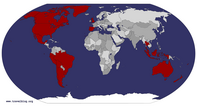The Pension Gapper Blogs: Mainland USA and Hawaii
July 22nd 2008 -» October 14th 2008
The Pension Gapper Blogs: Fiji and New Zealand
October 15th 2008 -» December 23rd 2008
The Pension Gapper Blogs: Australia and Indonesia
December 23rd 2008 -» February 28th 2009
The Pension Gapper Blogs: Singapore, Malaysia and Thailand
February 28th 2009 -» April 19th 2009
South America 2014/2015
October 25th 2014 -» February 27th 2015
Brazil 2015
May 16th 2015 -» July 12th 2015
Borneo 2018
April 10th 2018 -» June 2nd 2018
Canada
April 27th 2019 -» June 29th 2019
Island-hopping in Thailand 2020
February 1st 2020 -» February 29th 2020

















